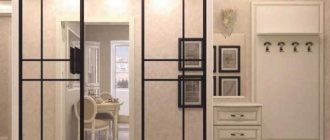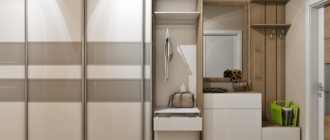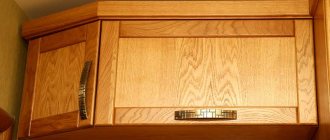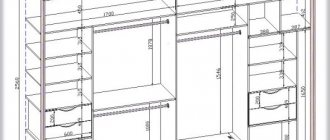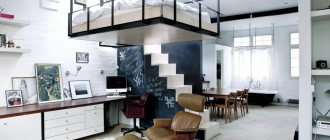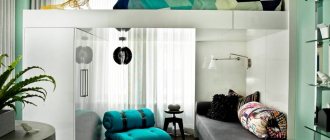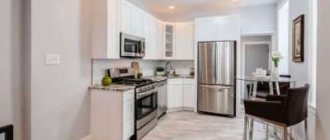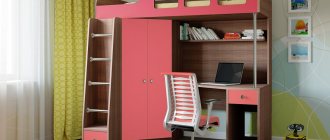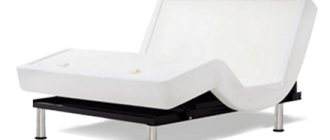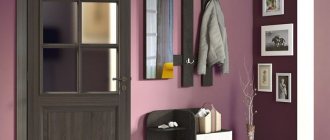Installation in different rooms
Furniture of this type is rarely placed in the hallway due to the small space next to the front door. It serves as a dressing room and shoe storage. The facade is made simple, closed, with swing doors. Installing open sections is undesirable because it creates a feeling of chaos in the hallway. You can leave a narrow corner section with hooks for clothes open. Sometimes a mini-seat and a mirror are built into the closet.
In the living room, it is better to make the closet around the door bright and catchy. A large number of open and glass sections allows you to display souvenirs, photographs, figurines, and decorations. You can store dishes and personal items in closed parts. Often a closet in a room with a classic design style is made into a library. If the design of the room is hi-tech or minimalist, add a shelf for a TV, retractable disk storage (if you still have them), sections for a video player, game console, and speakers.
In the kitchen, the wall near the door plays a decorative or functional role. In the first case, it consists of light shelves and racks for decorative dishes, plants, fruit baskets, expensive wines and other decorations. In the second option, fill the cabinet with drawers and shelves for spices, products with a long shelf life, cutlery, pots and other kitchen utensils. Select special open compartments for frequently used household appliances; the rest can be stored on the mezzanine.
In the bedroom, place a large but discreet wardrobe in the shape of a U. A simple front design with a minimum of open sections will not clutter the room, creating a peaceful, calm atmosphere. The design hides the door, additionally protecting from noise and bustle. The contents correspond to a classic dressing room - the basis is made up of sections for hanging rods, complemented by drawers for personal items, shelves for linen, pillows, blankets.
In the nursery, install combined models. A single storage system covering the entire wall will allow you to get rid of separate cabinets for toys, books, clothes, and educational supplies, which will save space. Leave the façade discreet or decorate it with drawings and photo wallpapers. Additionally, select a section for a desktop with a computer.
Doors – hinged, sliding, folding
The minimum number of doors in a closet is 3. 2 of them are located on the sides of the opening, the remaining one is on the section with the mezzanine. In practice, the number of doors is greater. In wall structures with open sections, you can count 8-12 doors, differing in size, height, and method of fastening.
The cabinets use 3 opening systems. Classic swing doors are hinged and opened with a handle on the outside. They are reliable, durable, and do not require additional maintenance, unlike sliding options. The service life of the opening system is 50 years with regular use.
Expert opinion
Bashir Rabadanov
Technologist at the furniture company Woodband
The maximum width of the swing door is 65 cm, otherwise it will warp and break. To use it, you need to allocate space in front of the cabinet, which reduces space savings. Poor quality swing systems are noisy and stick, so it is advisable to have them checked before ordering installation.
The second type of door is sliding, like a coupe. They move along guides on wheels, moving away and opening the opening. The closing system is smooth, silent, does not require additional space, and looks aesthetically pleasing. The disadvantages include the high price and the need to constantly care for the rollers, wiping and removing dust. The service life of a structure with a sliding door is 20-40 years.
The third type is folding doors. They are rare, only on wide models. The system consists of several canvases, fastened like a screen or accordion. When opened, they fold, slamming shut like a book. This allows you to see the entire contents of the cabinet while saving space in front of it.
The disadvantage of the folding system is low reliability. Due to the load on the top track, doors are easily broken when opened frequently. Their service life is 10-30 years.
When planning the doors, you should make sure that they do not intersect with each other, do not cover the entrance opening, or interfere with access to other furniture. Attention is given to free movement on loops or rails.
Types of cabinets around the doorway of the room
When designed correctly, cabinets around doors are suitable for all types of rooms from the bedroom to the hallway. There are many ready-made projects and design ideas. It is not necessary to copy them, you can study successful options and, through a combination, create an original and convenient one to suit your preferences and features of the room.
Most of the completed projects are U-shaped structures with mezzanines. They use two walls around the opening and the space on top of the door. Ideally, the door is located in the middle of the wall. This helps maintain symmetry.
Basically, all cabinets around the door are made with mezzanines.
L-shaped structures are made for rooms where the door is offset against the wall. Asymmetry can be hidden by using the same door and cabinet design. In this case, the owners additionally installed a mirror.
But there are exceptions. In this apartment, the ceilings are decorated with wide strips of stucco. Installing mezzanines will ruin the overall appearance of the room.
Spacious sliding wardrobe with mezzanine, g-shaped
Hallway
Models with a maximally closed facade are suitable for hallways. An abundance of open shelves with things will create a feeling of chaos already upon entering the apartment. The maximum that can be allowed is 1-2 open sections with hooks for outerwear and bags.
The cabinets around the doorways are similar to the mezzanine furniture in the hallway
Bedroom
The bedroom should have a calm atmosphere - without visual noise.
It is better to do without open shelving, bright details and colors.
This bedroom features a spacious and fully enclosed model, designed in soothing colors. Additionally, the design masks the passage door to the bathroom combined with the bedroom.
A cabinet around a doorway is a stylish and economical solution
Living room
Depending on the interior and preferences of the owners, any type of cabinet can be installed in the living room. It can combine open shelving, pull-out shelves and closed wardrobe sections. The cabinet can be used for a library, decorative elements, and a TV can be placed on it.
But in small apartments, it is better to install cabinets with a closed front in the living room.
You can place your wardrobe and seasonal items here.
You should choose the right color of furniture and combination of materials
Children's
In the nursery, combined models are often installed, where clothes and bedding are stored in closed sections, and toys and books are stored on open shelves.
The children's room is the place where the child is, you need to arrange it practically and rationally
Kitchen
Before designing a kitchen cabinet, you need to consider the features of the room and the main purpose of the installation.
In a small room, functional models for storing food and dishes are installed.
But if the room allows, the closet can also play an aesthetic role, disguising the entrance door.
Ideal place for a shelf
Often a mezzanine is placed directly above the front door if there is enough space. This will advantageously decorate the entrance to your home. The design can be installed in a long and narrow corridor.
Above the entrance and in the corridor
Mezzanine above the entrance to the hallway.
Between rooms
Double-sided structures are installed through the door. You get two access points from different rooms. At the same time, the appearance of the rooms should not be spoiled. For example, if a door leads from the corridor to the living room, the shelf in it should be compatible in style with the interior of the room.
Mezzanine between rooms.
Gallery installation
If there is a niche in the hallway or just a lot of space, installing a gallery mezzanine is suitable. It will occupy the entire space from ceiling to floor, from wall to wall, around the entire perimeter. And it will have different functions: shelves for accessories, a wardrobe, and shoe stands.
Gallery mezzanine in the hallway.
A hallway with mezzanines may have other functions besides storing household utensils. You can arrange a library on the shelves if you have a lot of books in the house.
Choosing a wardrobe for various corridors
For an apartment with a small hallway, for example, in a Khrushchev-era building, small wardrobes with two doors, linear or corner, are most suitable. In such a small room, it is most convenient to place them near the corner by the front door.
Double-leaf wardrobe in a small hallway of a Khrushchev building
In a very narrow corridor, it is better to place cabinets, the depth of which does not exceed forty centimeters, but at the same time quite high, this will increase the occupancy of the furniture. And the mirrored doors used will create the illusion of wide space and add light. It is better to arrange the furniture in this order: first the hanger, then the shoe cabinet, and only then the wardrobe. When buying a wardrobe for a narrow corridor, the future owner should also take into account the color of the furniture - too dark will visually make the room even cramped, it is better to choose light-colored furniture.
Mirror doors will make a narrow corridor much brighter and visually expand the space
It is advisable to visually divide a long corridor into several zones. Furniture placed in them with lighting and mirrored doors will add some complexity and volume to the interior. You should not install a mirrored wardrobe at the end of a long corridor, this will make the room very uncomfortable and even more elongated; if necessary, it is better to use facades made to look like natural wood.
Combination of an open hanger with a shoe rack and a spacious wardrobe with four doors
In what cases is a mezzanine needed?
Owners of their own houses can be said to be luckier than residents of apartment buildings. In a private home, you are free to design your hallway so that it only serves as a place where you can take off your street clothes and not visit it until the next time you leave the house.
But the owners of apartments, especially those built in the Soviet era of the Khrushchev type, are forced to think about arranging the hallway so that it can accommodate an often large amount of clothes, shoes and much more important things, while remaining as spacious as possible. The mezzanine does an excellent job of storing household belongings while remaining unnoticeable and not interfering with the passageway of the corridor.
What is a mezzanine?
How to zone
For many, organizing a dressing room in the bedroom becomes an impossible task. Not every owner of a typical apartment can afford such projects. Modern design solutions will help you find a way out of the situation and make your dream come true. You can easily carry out budget zoning with your own hands and create a convenient place to store all your things that will harmoniously fit into the interior. It does not have to be combined with furniture.
Plasterboard partition
This zoning option is suitable for premises that do not have adjacent buildings. More often, a linear storage option is used, when a partition or curtain is placed along one of the walls. When planning to separate the dressing room with plasterboard, you should take into account the features of the room, the location of window and door openings.
A parallel dressing room is suitable for small bedrooms. Its main advantage is its large capacity. Shelves are mounted on the wall, and hangers are mounted on the partition itself. This arrangement is very convenient and allows you to store a large number of things, including bulky, seasonal clothes.
Built-in wardrobe
For a small bedroom, such a dressing room will be a real find. The built-in wardrobe will merge with the overall interior and become an integral part of the room. They occupy maximum space from floor to ceiling, which allows you to place more shelves and storage drawers. All models will fit well into any room with a non-standard layout, which will avoid gaps between the cabinet wall and the vertical surface.
Sliding doors with roller shutters
One of the most popular and economical options for master bedrooms with any layout. Such door designs are especially suitable for small rooms where it is simply necessary to save space. Regarding the design, sliding doors with roller shutters to the dressing room can be divided into the following types:
- Recoil. Each door quietly and smoothly enters its own niche. They can be made of any material (wood, glass, plastic);
- Sliding doors. Both sides can easily walk on the roller shutters parallel to each other. If they are opened at the same time, a small passage to the dressing room is formed;
- Techno designs. Such doors are often made to order. They are fixed only in the upper part, while the lower part remains suspended and moves freely;
- Foldable. The largest type of roller shutter door. Individual elements are folded in half and moved away;
- An accordion. Has more folds than straight designs. More often they are one-sided.
Types of doors
Canvases come in different designs. The most commonly installed types are:
For a classic-style interior, choose wooden doors with a mirror. This will make the room appear larger.
All these designs are very compact. With the exception of swing doors: they do not open like standard interior doors. The wooden (or plastic) sheet is usually carefully moved or assembled. Therefore, all designs are suitable for installation and installation in small spaces.
Swing
This design is a door leaf to which a handle is attached. There are such doors in every apartment. They can be placed in a niche only if the room is spacious and the opening door will not interfere or rest against furniture or a wall.
Swing models are suitable for placement in the corridor or on the balcony. You can put a double-leaf structure here - it looks even more interesting. Single doors are suitable for recesses approximately the same width as the doorway.
Sliding
If the niche is too wide, it can be hidden behind sliding doors. The canvas is mounted on a rail and can move in any direction. This is the design of the wardrobe.
Such canvases are ideal for a closet or dressing room. They can be placed in an opening of any width.
Sliding doors for niches do not take up much space and are suitable for any room. Usually behind them there is a hidden dressing room or wardrobe for outerwear. You can attach a mirror to one of the canvases.
Folding
Such canvases consist of two identical halves, which are assembled with an accordion in one movement. This is a very compact and convenient design, which when opened creates a wide doorway.
Folding products are often installed in the hallway, bedroom or on the balcony. For the corridor, it is better to order models of the same design as the interior ones. Then they will not violate the overall concept of the interior.
Louvre
They are ideal for small recesses converted into cabinets. They can be used to close a square or arched opening. It is better to choose louver structures made of wood or colored plastic. Iron blinds are suitable for office interiors.
In a niche with such doors you can put beautiful cardboard boxes or rattan baskets. They will be visible through the blinds. Such canvases are also suitable for the kitchen. You can hide jars of cereals and spices behind them.
Materials for making cabinets
For the manufacture of sliding wardrobes, the same materials are used as for conventional wardrobes. The choice is limited only by the customer's budget. Additionally, only guides for the cabinet door panels will be used; they distinguish sliding wardrobes from other furniture.
The materials and fittings used in the manufacture of the cabinet significantly affect the cost of the product
From chipboard and MDF
Chipboard and MDF are the most common and simplest options for making any cabinet furniture, which are based on wood chips and resins. The advantage of these materials is their lightness, variety of shades and textures. They are made in various thicknesses, both with and without lamination.
Built-in wardrobe with doors made of laminated chipboard in a minimalist style hallway
For some cabinet elements, mainly for the back wall, fiberboard is used. This material is very sensitive to humidity and this must be taken into account when installing cabinets along walls facing the street. Lack of ventilation will lead to condensation and blooming of the back wall.
Made from natural wood
Cabinets made of solid wood undoubtedly look very solid, impressive and stylish. But they are also the most expensive. This option is suitable for a classic luxurious interior of a spacious hallway.
A solid wood cabinet will look good together with other furniture made in a similar style
As a rule, natural wood is used for external walls and facades, and the internal filling is made of cheaper material.
Other materials used for the manufacture of sliding wardrobes
Much less common are sliding wardrobes in which the doors are made of plastic and aluminum. But nevertheless, they also find their place in modern interiors in the Art Nouveau, loft and other styles. Such products look quite impressive, but require an appropriate environment.
Original design from combined materials in an industrial style
Decorating Tips
There are also many options for how to decorate doors beautifully. For example, they can be covered with artificial leather . Then such a mezzanine will look organic together with the front door or the design of furniture in the hallway. You can even try and create the effect of a carriage tie using a stapler from the outside. In this case, the paper clips are decorated with buttons, which are previously covered with leatherette. In some variations, plastic rhinestones are used instead of buttons.
Cabinet interior options
The photo of the built-in hallways shows that rational and thoughtful filling of the closet can combine aesthetics, style and functionality. With a competent approach to organizing space, you can significantly increase the capacity of even a small model, make every nook and cranny easily accessible and convenient, and also provide the contents with proper storage conditions with good ventilation.
The functionality of the cabinet and ease of use depend on the content.
Clothes compartments
For long outerwear, it is necessary to arrange a compartment in which hangers can be placed. If the width of the cabinet exceeds 60 cm, a crossbar is installed at shoulder level, onto which the hangers are attached. If the width of the cabinet is less than 45 cm, then it is optimal to use retractable structures in the form of transverse rods attached to the shelf, on which hangers are placed parallel to the door. At the same time, it is more convenient to place them above head level.
The main area of the closet is allocated for placing outerwear
The height of this section depends on the type of things you plan to store. So, 130-150 cm will be optimal for coats and raincoats, and 90-120 cm for jackets and jackets. Of course, the height of the owner plays a significant role.
It is advisable to divide a tall cabinet into two zones: upper and lower
If the height of the cabinet exceeds 220 cm, then in one compartment you can place two storage spaces in the form of crossbars with hangers. To do this, a pantograph, that is, a crossbar with a lifting mechanism, is installed in the upper part of the section instead of a bar.
Shoe maker
The lower section of the closet is reserved for shoes, in which it is best to install mesh shelves. They have the following advantages:
- better overview of stored pairs;
- protection of shoes from dirt and dust;
- comfortable placement of models with heels.
It is rational to use retractable shoe rack systems, in which several narrow mesh shelves can be placed, attached to the side or back wall. It is better to place them at a slight tilt forward.
The simplest shoe rack in the form of hanging shelves
Easier to use pull-out shoe rack
The height of this compartment is very variable and depends on the amount of shoes expected to be stored.
Boxes
At the top of the cabinet there is a fairly large section reserved for storing bulky, infrequently used items. The height of this section is usually about 60 cm, but may vary depending on specific requests.
The built-in mezzanine located above the front door is perfect for storing rarely used items.
The remaining space in the cabinet is freely and randomly filled with shelves, pull-out wire baskets or drawers. They are designed to store hats, scarves, gloves, bags and other accessories. Space is also often allocated for placing umbrellas, which is especially important for “cane” type models.
The compartment in which the drawer is located should be narrower than the width of the door. Otherwise, the drawers will not be able to slide out.
Retractable elements can be installed either on budget roller mechanisms, which are noisy and not very durable, or on more expensive, but also more reliable and durable telescopic guides on ball bearings.
Drawers are convenient for storing a wide variety of things and accessories
Standard boxes are a box made of chipboard with a bottom made of fiberboard. In this case, the texture of the front part must correspond to the facade of the cabinet.
Suitable location for the superstructure
So, we’ve sorted out the materials, now we need to think about how our mezzanine will be located and what needs to be taken into account in order to avoid mistakes when assembling and placing it.
In order for the mezzanine to be used harmoniously, you need to choose a convenient place for it
As already mentioned, the mezzanine is located under the ceiling in any of the rooms in the apartment, but if it is a corridor, then the most frequently used and convenient place is above the entrance door to the kitchen. When installing the structure, consider some points that you should pay special attention to:
There should be no gaps between the ceiling and the storage area
How to design the bottom
According to design rules, the lower part of the shelf should not stand out too much. If laminated chipboard is used for its manufacture, the color chosen is light, matching the color of the ceiling. If it is drywall, painting is recommended. Wooden surfaces are covered with stain and varnished to match the facade. It is possible to make a suspended or suspended ceiling under a shelf, but it will take up at least 5 cm of height. Fans of non-standard solutions cover it with mirrored plexiglass.
No matter how convenient and durable the hanging structure itself is, the design of the apartment should not suffer from its presence.
There is no need to try to disguise the mezzanine in the hallway. It needs to be made a full-fledged component of the interior, then the whole environment will be cozy and harmonious.
In modern hallway interiors, open models are often found. In appearance, these mezzanines resemble a furniture shelf.
What mezzanines look like in different styles of corridor and hallway
If the mezzanine is not part of the furniture set, it is important that it is in harmony with it. Sometimes when updating furniture it is worth thinking about changing the facade for the shelf under the ceiling
There are many examples when stylistic contradictions spoiled all impressions of the setting. Thus, an oak facade will be completely out of place in a minimalist interior, and shelves with curtains will never find their place in a classic.
The standard and most common type is the mounted model, located under the ceiling.
Modern
The main condition of the style is harmony; everything must be done in one key. Consequently, the design of the mezzanine largely depends on the type and color of furniture and decoration. Modernism does not limit the materials used. The sliding doors of the mezzanine can be decorated with stained glass, if they complement the rest of the decor. They can even be decorated with forged elements if there is a staircase with such railings nearby. MDF facades remain the main finishing material.
Thanks to the appropriate finishing, such designs fit well into the interior.
Classic
Increasingly, luxurious and elegant classics are found in ordinary medium- and large-sized hallways. The basis of the composition is oversized furniture with quilted leather inserts and beveled mirrors. Even if the mezzanine above the door in the corridor is not part of the set, it will not be difficult to make it interesting.
Cabinet structures are attached directly to furniture. Typically, these mezzanines are located on the upper tiers of cabinets.
The material for the facade can be natural wood or MDF with a good texture. The doors, decorated with leather inserts that imitate a carriage frame, look original. Along the perimeter, a niche can be highlighted with stucco, even to the point of creating a support for the shelf on the walls in the form of semi-columns. The bottom of the shelf can be decorated with acrylic mirror plastic and diamonds.
The size of the internal space of such a design will depend on the height of the cabinet and the free space between the upper tier and the ceiling of the room.
Advice! When arranging deep niches, it is worth thinking about additional lighting. The best option would be an LED ceiling light for the closet.
Minimalism
In the hallway, where there is nothing superfluous, the ceiling structure should not attract attention. The doors are made of MDF with a plastic coating. They cover the entire niche completely
Fittings without handles are used and open upward when pressed. Facades made of tinted plexiglass would also be appropriate.
The advantage of wall cabinets is that they do not take up free space on the floor.
Contemporary
This style has long filled homes and won hearts, but many mistakenly continue to call it modern. The word "Contemporary" means "modern". Comfort in the interior is created with the help of inexpensive items, smooth surfaces and a minimum of decor. The mezzanine in the contemporary corridor under the ceiling should be discreet. Doors made of laminated chipboard or MDF with plastic coating are suitable.
When choosing suitable furniture, you should definitely take into account the design features.
Country
In a unique rustic style, simplicity and naturalness prevail. A checkered curtain or a painted swing door with a round wooden handle will suffice here. The niche can remain open to store small items in wicker baskets.
Most often, the hallway is chosen to place hanging structures.
Provence
Natural materials and pastel colors predominate. It is allowed to paint any surface with light paint, including wooden furniture. The facades can be solid or in the form of doors with wooden blinds. It is appropriate to use decoration using decoupage.
Another suitable place to place a mezzanine is a long corridor.
How to make a mezzanine from chipboard or plywood
There are two options here. Make a mezzanine for the kitchen by analogy with the previous method. That is:
By the way, the facades can be made not hinged, but sliding, but the access will be exactly twice as wide as the width of the sliding door. Therefore, if you plan to use the mezzanine in the kitchen above the door in the hallway for storing large items, it is better to abandon this idea.
As the bottom you need to use plywood, solid wood or clapboard type boards - any fibrous material. The chipboard is too fragile, the chips do not provide the necessary elasticity and the bottom, without additional rigidity, will simply bend and break under its own weight.
The second option is to assemble a full-fledged cabinet, with its own walls (possibly without a roof), lift it and slide it onto special mortgages in the form of planks or a metal corner.
Such a cabinet will “stand” on the side supports on both sides and on the door jamb on the third side. You can make a mezzanine in the apartment through, opening from both sides, from the kitchen and from the hallway, if necessary.
The design will look like this.
The main thing is to correctly measure the niche from all sides. The bottom of the mezzanine cabinet in the corridor above the door is made larger than the side walls. That is, the side walls move slightly (a couple of centimeters) towards the center. This play will help the mezzanine “stand up” more tightly when the walls converge or diverge. After all, you can always file the bottom in place - and the side walls will not interfere with this.
One more nuance. If you make a mezzanine in the hallway/kitchen from chipboard, then you need to install a stiffener that would strengthen the bottom. But it’s better, as I wrote above, to choose plywood or solid wood.
It is impossible to say for sure which method is better to choose to make a mezzanine with your own hands. It all depends on your skills and idea of what the end result should look like.
How to close
A hallway with open mezzanines can become uncomfortable due to cluttered shelves. Then you will have to make a facade. Doors taken from old unnecessary furniture or purchased separately are suitable. If they open upward, the handles should not hit the ceiling. Another option is to install sliding ceilings. When using soft barriers such as a curtain, remember that they are just decoration. They will not hold objects, which may be unsafe. However, they will help protect things from dust.
Doors for the mezzanine.
When it comes to indoor design, the question of combining functionality and style always comes up. If the existing cabinets and bedside tables are not enough, the mezzanine in the hallway already solves the first problem for its intended purpose. And making the right choice, based on the information above and a basic sense of taste, will help give your interior a beautiful look.
A little about the approach to repairing and ordering furniture
It would be foolish to refuse a convenient and spacious cabinet above the kitchen door. Therefore, few people completely demolish it - most often, during repairs, owners are interested in the question of how to make a mezzanine with their own hands in the corridor, update the structure itself and the external design.
Personally, I am somewhat skeptical about towns and cities with all sorts of nailed-on blocks and strips in attempts to create a mezzanine in the kitchen with minimal effort. They come up with everything they can - they paint over old plywood structures with a thick layer of paint, glue on decorative film and even oilcloth just to somehow improve the look of outdated furniture. All this is useless. As they say, the horse is dead, get off it. If you do it, then do it. Take out the old stuff completely and make a normal, new mezzanine.
Let's consider both options.
The main stages of creating a stationary mezzanine
First of all, prepare the necessary material and decide on the size of the future superstructure. After this, you can begin creating the drawing. Calculate the length and width of the furniture panels and distribute them in such a way that you have as little waste as possible. There will be shelves inside, and metal corners on the sides to strengthen the structure. According to the drawing, we mark individual parts on the material and cut them out using a jigsaw or circular saw. Each individual element of the mezzanine façade is processed using a milling machine.
Pay special attention to the doors. We make the internal shelves of the product from chipboard or plasterboard. Their thickness should be sufficient to support the weight of the things you plan to put in the mezzanine. We connect all the structural parts using self-tapping screws
We attach metal “ears” to the rear panel, which are necessary for attaching the mezzanine.
The doors of the product can be sliding or hinged. Use self-adhesive, veneer, or paint as decoration. If you are not confident in your design capabilities, you can make a mezzanine yourself, and order the production of decorative doors from the workshop that will harmoniously complement the interior of the room.
Product mounting options
There are two most common ways to securely attach a stationary mezzanine:
- Use of wooden beams. To do this, you will need blocks with drilled holes every 25 cm. Use a building level to draw a perfectly straight line on the wall. We attach wooden elements to it and make a mark in each hole. Using a drill, we make holes 60 mm deep, and insert plastic dowels into each. After this, you can safely fasten the rail with reliable self-tapping screws. This mounting method is suitable for installing a mezzanine between two walls.
- Using a metal profile. For such work, you will need a PN 28x27mm ceiling profile, which must be secured around the perimeter of the lower part of the product. We make cross members from PP 60x27 mm. The lower part of such a frame is necessarily sheathed with plasterboard, and the top is covered with a durable sheet of plywood. The structure must be rigid enough to support the weight of the mezzanine with things and not bend.
Use the advice of professionals to correctly and accurately fasten the structure.
- The bottom of the shelf must be at a height of at least 2 meters. All the remaining space up to the ceiling can be taken up with things.
- If you are mounting the structure above the front door, make sure that the bottom is aligned with the top of the doorway. This way the mezzanine will look more harmonious.
- There should be no free space between the top of the product and the ceiling. This area will not be useful to you in any way and will only collect dust.
- Do not install the mezzanine in close proximity to the light source if you do not want to darken the room.
How to make a mezzanine from plasterboard
If after the repair there are pieces of a metal profile and a small remainder of drywall, that can also be used. It is enough to assemble a frame for fastening the bottom and make some kind of mortgages for fastening the facade.
Be careful - there is usually wiring in the adjacent wall. It would be a good idea to “ring” the intended drilling locations with a special tool so as not to touch the wires.
The assembled frame can be sheathed not only with plasterboard, but also with any light sheet material. For example, thin plywood or thick fiberboard.
After covering the mezzanine frame with wallpaper, all that remains is to make the façade part. There are two opening options - a folding top or a side-hinged one. The facades are matched to the overall style of the kitchen; the easiest way is to order them from the same material as the doors. For example, MDF or acrylic.
In any case, you will need to lay a narrow strip to which furniture hinges for false panels will be attached. In the first case, there will be one vertical plank, in the second - two horizontal ones on both sides of the mezzanine.
Style options for furniture
The styles of cabinet furniture for the hallway are as diverse as for other rooms. Even an entrance hall for a narrow and small corridor in a house that has lived to be a hundred years old can look great in the spirit of modern minimalism. They are famous for their Scandinavian style with carefully thought-out solutions, ergonomic details, and original approaches to arranging a place for every item.
The photo shows built-in wardrobes in a hallway decorated in Scandinavian style
The photo shows a hallway in a minimalist style with matte facades
In contrast to the extremely restrained colors of the Scandinavian style, there is a tropical style - with bright colors that, at first glance, barely combine with each other, but create a feeling of warmth, fun and constant fiesta. If you decide to move away from the usual pastel shades, then you should make sure that your eyes can withstand this
It is very important to make sure that the colors of the furniture, walls and floors are a truly creative combination. The entrance hall to a narrow corridor with a wardrobe in the photo looks very impressive
The tropical interior style welcomes natural materials with exotic accents
Two in one: library and decor element
Unusual modular bookshelves can become one of the accents of the interior of a living room or office. The main advantage is the ease of implementation of the idea. In addition, among the large number of variations of shelves, there is sure to be one that will enliven the room and emphasize its advantages.
Among the disadvantages, perhaps, is only the limited capacity of such shelves.
Photo: shelterness.com
1/3
Photo: home-designing.com
2/3
Photo: freshouz.com
3/3
Pros and cons of built-in hallway wardrobes
Built-in wardrobes are widely popular, which is well deserved, because they are one of the most functional classic models.
Built-in furniture has a fairly impressive list of advantages
The following advantages can be highlighted:
- Predominant development for individual needs.
- Full compliance with the dimensions of the room.
- Monolithic connection to the floor, ceiling and walls, no gaps.
- High structural stability.
- Possibility of saving space.
- Variability of capacity and filling features.
- Possibility of mounting on uneven areas of walls.
At the same time, a significant advantage of built-in models is their ability to be mounted on any part of the hallway - against a wall, in a corner, a niche or near a doorway.
When designing a structure, it is necessary to take into account the overall interior of the apartment and select a facade that harmonizes with it.
Perhaps the only drawback of built-in cabinets is the lack of mobility and the possibility of partial reassembly, since the structure is mounted directly into the wall.
A properly selected wardrobe will be an ideal addition to the interior of the hallway.
Advantages and disadvantages
Placing the cabinet around the doorway along the entire plane of the wall helps free up several square meters and visually expands the room.
- in small spaces and, if necessary, store a lot of things;
- in rooms with niches, uneven walls and corners;
- if desired, organize more free space;
- when you need to create an original design, disguise the door.
The main disadvantage is that it cannot be moved to another place. That is, you need to be prepared that the structure will stand in one place for more than one year.
But there are many more advantages:
- Large capacity. The design uses hard-to-reach places under the ceiling and above the doors. This is additional storage space for things. Depth - from 60 cm, but if the room allows you can do more.
- Internal filling. The ability to design the layout of shelves and departments yourself, depending on the characteristics of everyday life and the purpose of the cabinet.
- Visual space. When entering the room, the bulky one remains behind your back, visually making the room more spacious. The right color helps to prolong this feeling while you are in the room.
- Relatively low price. It will be cheaper compared to other built-in wardrobes with similar characteristics. The cost is reduced due to savings on materials, because the role of the back wall, sides and top rack is played by the walls and ceiling.
Popular materials for making mezzanines: what is better to choose from a design point of view
The list of materials for making mezzanines is limited.
Tree. The results are aesthetic and environmentally friendly designs. The disadvantages include the high cost and the need to have woodworking tools when making them yourself. The risk of deformation due to temperature changes is minimal, but the walls must be strong enough to support the weight of the wooden cabinet and its contents.
The space near the entrance door under the ceiling is unoccupied, and placing a decorated wall shelf there will make it useful and decorate the space.
Drywall. The price of the arrangement will ultimately be relatively low. Suitable for the manufacture of non-standard elements. For example, when the opening is formed by an arch, and its upper part is the facade of a niche. The appearance is quite discreet. With a properly assembled frame, the bottom of the shelf can withstand a lot of weight. The disadvantages include the need for priming, putty and finishing of the structure, so a plasterboard mezzanine should be made in the initial stages of repair.
A double-sided mezzanine can be hung in a long passage; it will have doors on both sides
Chipboard and MDF have a smooth surface and are inexpensive. It is well suited for the construction of furniture mezzanines, but it can also be used to make stationary ones. A frame is assembled from wooden beams onto which the panel is attached. Installation is possible upon completion of repair work. The material can be used to make individual cabinets that can be hung on the wall anywhere and at any time.
If there is no free space, you should pay attention to sliding models with doors
